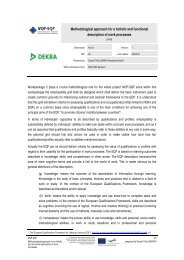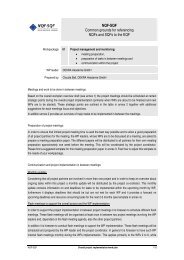Overview of National Qualification frameworks - Project-Nqf-Sqf
Overview of National Qualification frameworks - Project-Nqf-Sqf
Overview of National Qualification frameworks - Project-Nqf-Sqf
Create successful ePaper yourself
Turn your PDF publications into a flip-book with our unique Google optimized e-Paper software.
For countries that don’t plan to introduce an NQF:__Are there plans to implement the EQF? If so, please describe.2 Segments <strong>of</strong> the educational system__ Which segments <strong>of</strong> the educational system are differentiated in your country (e.g. GeneralEducation, Vocational schools / dual system 1 , VET, Higher Education, Adult Education)? Pleasegive a short survey in note form.Primary school (Grundschule) (ages 6 to 10)General secondary school (Hauptschule) (ages 10 to 14)● Within certain limits, each school may develop its own special pr<strong>of</strong>ile (e.g. languages, music, art anddesign, sports, science, ecology, computer science, etc.).● In addition, there are special types with a sports or music and arts bias.Special school (Sonderschule) (ages 6 to 15)Special schools comprise eight grades, or nine if polytechnic schools or a career preparation year aretaken into account. They comprise ten different branches. Students receive a basic education fromspecially trained teachers who use methods tailored to meet the child’s individual requirements; thisschooling is designed to prepare the student for career training or further education.Polytechnic school (Polytechnische Schule) (ages 14 to 15)Polytechnic schools can be attended after the eighth school grade and comprise only one grade. In theninth, or a voluntary tenth school year, students are prepared for later life and especially for a careerwith more in-depth general education classes, career orientation and basic vocational training. Anorientation period at the start <strong>of</strong> the school year and career orientation as the basic goal <strong>of</strong> all coursescreate numerous opportunities for students to become familiar with working life.Model test “New Middle School” (Neue Mittelschule)The goal <strong>of</strong> models tests with the new middle school is to provide a joint school for all 10- to 14-yearolds that is open to all students who have completed the fourth grade in primary school.Academic Secondary School (Allgemein bildende höhere Schule)The academic secondary school comprises a four-year lower level and a four-year upper levelterminating in the Reifeprüfung (matriculation exam), which is an entrance exam for university, highertechnical college, post-secondary college and academies.Special types:● Allgemeinbildende höhere Schulen (academic secondary schools) with an arts or sports bias andaptitude test● Aufbaugymnasium (language bias) and Aufbaurealgymnasium (science bias) (in some cases withtransition stage; fifth to eighth form):● Gymnasium, Realgymnasium and Wirtschaftskundliches Realgymnasium für Berufstatige (science,mathematics or homeeconomics bias and schools for working people): evening or longdistance classes,duration eight semesters1 Dual system: In countries such as in Austria or Germany apprenticeship training takes places at two differentsites: company-based training <strong>of</strong> apprentices is complemented by compulsory attendance <strong>of</strong> a part-time vocationalschool for apprentices [“Berufsschule”]. Thus, apprenticeship training is also referred to as “dual vocationaltraining system” or as “dual system”.




